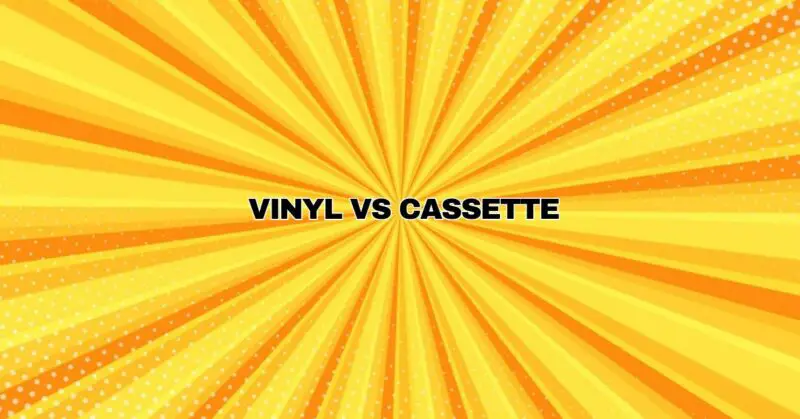In an age dominated by digital music streaming and high-definition audio formats, the revival of analog music mediums like vinyl records and cassette tapes is a remarkable phenomenon. Both vinyl and cassette tapes have experienced resurgence among audiophiles, collectors, and music enthusiasts seeking a tangible connection to their favorite tunes. In this comprehensive article, we will delve into the characteristics, advantages, limitations, and enduring appeal of both vinyl and cassette tapes to better understand their unique positions in the world of analog audio.
Vinyl Records: The Timeless Classic
Characteristics of Vinyl Records:
- Analog Grooves: Vinyl records store audio information in the form of continuous analog grooves etched onto the surface. These grooves are read by a stylus (needle) that translates the physical movements into sound.
- Large Format: Vinyl records are typically 12 inches in diameter for full-length albums and 7 inches for singles. This large format allows for extensive album art and detailed packaging.
- Analog Warmth: Vinyl records are celebrated for their warm, rich, and harmonically complex sound. The analog format adds depth, character, and warmth to the music.
- Tangible Experience: Playing a vinyl record involves tactile interaction, from carefully handling the record to gently placing it on a turntable. The physicality of vinyl adds to the listening experience.
Advantages of Vinyl Records:
- High-Quality Sound: Vinyl records offer high-fidelity sound, particularly appreciated by audiophiles. The analog format captures nuances and harmonics that can be lost in digital conversions.
- Collector’s Appeal: Vinyl records hold significant collector’s value, with rare and limited editions fetching high prices in the market. Collectors appreciate the history and uniqueness of vinyl pressings.
- Artistic Expression: Vinyl records allow for creative and artistic pressings, including colored vinyl, picture discs, and intricate etchings on the surface.
- Tangible Connection: Vinyl provides a tangible connection to music, allowing listeners to engage with their collections in a more deliberate and mindful way.
Cassette Tapes: The Compact Nostalgia
Characteristics of Cassette Tapes:
- Magnetic Tape: Cassette tapes use magnetic tape to store audio. The tape is wound between two spools and is read by a playback head.
- Compact Size: Cassette tapes are compact, making them portable and convenient for on-the-go listening.
- Reversible Playback: Cassettes allow for reversible playback, enabling listeners to rewind and fast forward to specific tracks or sections.
- Dolby Noise Reduction: Many cassette tapes feature Dolby noise reduction systems to reduce tape hiss and improve audio quality.
Advantages of Cassette Tapes:
- Portability: Cassette tapes are highly portable and were the medium of choice for personal music players like Walkmans in the 1980s and 1990s.
- Nostalgic Appeal: Cassette tapes evoke nostalgia for those who grew up with them, making them popular among collectors and retro enthusiasts.
- DIY Culture: Cassette tapes played a significant role in the DIY music culture, allowing independent artists to distribute their music affordably.
- Mixtapes and Personalization: Cassette tapes were used to create mixtapes, a personalized form of music curation and gifting.
Comparison: Vinyl vs. Cassette
Sound Quality:
- Vinyl: Vinyl records offer high-fidelity sound with warmth and depth. They are favored for audiophile listening.
- Cassette: Cassette tapes have limitations in sound quality due to their compact size and use of magnetic tape. While nostalgic, they may not meet audiophile standards.
Portability and Convenience:
- Vinyl: Vinyl records are not portable and require turntables for playback. They are designed for home listening.
- Cassette: Cassette tapes are portable and ideal for on-the-go listening, making them versatile for personal use.
Collectibility:
- Vinyl: Vinyl records hold significant collector’s value, with rare pressings and editions highly sought after.
- Cassette: While cassette tapes are collected for their nostalgic value, their collectibility tends to be less pronounced compared to vinyl.
Artistic Expression:
- Vinyl: Vinyl records allow for elaborate and artistic packaging, including unique pressings and cover art.
- Cassette: Cassette tapes offer some artistic potential, with variations in tape color and limited-edition releases.
Tangible Experience:
- Vinyl: Vinyl provides a tactile and immersive listening experience.
- Cassette: Cassette tapes offer a tangible connection to music through manual handling and playback.
Resurgence and Modern Appeal:
- Vinyl: Vinyl records have experienced a substantial resurgence, with new releases and reissues available for contemporary music.
- Cassette: Cassette tapes have seen a niche resurgence, appealing to retro enthusiasts and independent artists.
Conclusion
In the vinyl vs. cassette debate, both analog formats offer unique characteristics and a distinct listening experience. Vinyl records excel in sound quality, collector’s appeal, and the immersive experience they provide. On the other hand, cassette tapes are beloved for their portability, nostalgic value, and historical significance in DIY music culture.
Ultimately, the choice between vinyl and cassette tapes depends on individual preferences, audiophile considerations, and sentimental connections to each format. Both vinyl and cassette tapes continue to coexist, each contributing to the diverse and multifaceted world of analog audio in the modern era. Whether you gravitate toward the warm, immersive sound of vinyl or the portable nostalgia of cassettes, both formats have a place in the hearts of music enthusiasts around the world.


